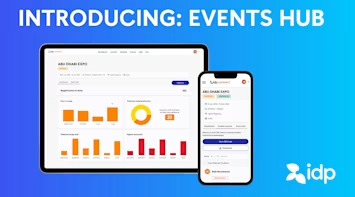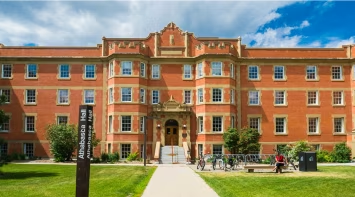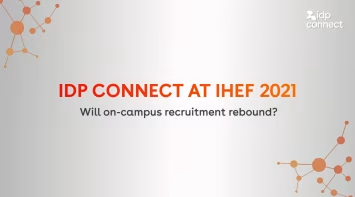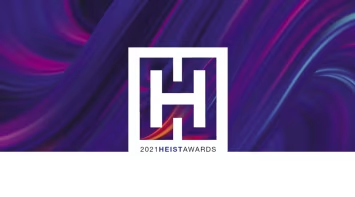Introduction
Waiting can be stressful, just ask any budding international student. Studying abroad requires lots of research and planning, and time is of the essence for prospective international students waiting to hear if their applications have been successful. With the industry experiencing a substantial rebound following the COVID-19 pandemic, IDP leveraged decades of education sector expertise as well as its embrace of AI and cutting-edge technology, to help institutions better manage increased demand while also boosting applicant satisfaction. The result is FastLane, a system which helps to ease the stress of applying to overseas institutions by streamlining the process as a whole. So, how does it work?
FastLane in Action
Launched alongside the IDP Live app in 2021, FastLane is an online system which combines our counsellors’ expertise with the latest in data science and AI technology to help students receive a streamlined offer-in-principle. It is a simple, six step process:
The applying student, or their counsellor, enters their grades and English language scores into FastLane, which is accessed via the IDP Live app
If the student meets the requirements, then an offer in principle is generated
An IDP counsellor verifies the student’s documents and grades
The counsellor submits the full application with the offer-in-principle ID
The application is then fast-tracked by the institution’s admissions team
The student receives a firm offer within two working days of submitting their application.
Since its launch, FastLane has become an integral part of IDP’s suite of products and services and has benefited over a hundred institutions and thousands of applicants worldwide. As of February 2024, 52,000 students submitted applications via FastLane. Since the initiative launched, over 75%, or nearly 40,000, of all applicants have received offers. With over 100 unique partner universities live on FastLane across Australia, the UK, Canada, and New Zealand, the program is steadily growing in popularity worldwide. With so many institutions now promoting courses through FastLane, how has the experience fared for them so far?
What do Institutions Think of FastLane?
Victoria University of Wellington (VUW) has been an IDP Core Partner for many years, and when they signed on as a FastLane partner, they felt confident that IDP’s initiative would help them reach their desired target market. VUW Associate Director of International Relations, Alsu Sworder said adopting technologies like FastLane was not only important for her institution’s recruitment efforts, but also in helping the New Zealand sector rebound from a challenging start to the decade.
“New Zealand is not a big player in international education industry, with little resource and visibility,” Ms Sworder said. “Innovative technology is key to maximising our potential and to ensuring we are well placed to grow where opportunities are identified for New Zealand in the future.”
Similarly, William Ho, Director of International Relations and Recruitment at Auckland University of Technology (AUT) said adopting forward-thinking technologies like FastLane were key to ensuring New Zealand remained a competitive destination market.
“It allows New Zealand to stay ahead of the game, particularly as competition for international students becomes increasingly more intense than ever before in the post-COVID era,” he said.

Mr Ho further explained that adopting FastLane was an important step in simplifying the recruitment process for prospective students.
“FastLane is personalised, easy to understand, and easy to use for students. It shortens the admission decision turnaround time considerably as well as providing qualified applications. AUT strives to improve the efficiency of our systems and processes and provide students with the best experience through their student journey,” Mr Ho said.
“Partnering with IDP on FastLane will ensure prospective students interested in studying at AUT a seamless application experience which ultimately leads to improved admission turnaround time and application to enrolment conversion rate.”
For Amm Jones, Assistant Director of International Admissions at RMIT in Melbourne, the decision to use FastLane was based on overcoming border closures and the resulting absence of traditional face-to-face methods. Ms Jones said outcomes from using FastLane had so far been promising.
“We have seen an improvement on quality of our applications, resulting in high conversion rate from applications to offers and subsequently enrolment, enhancing both applicant's and staff's experience,” she said.

“While our recruitment team will continue engaging prospective students and their families through our traditional channels, FastLane has provided the team with an opportunity to have more meaningful conversations with FastLane offer holders on our digital and traditional recruitment platforms.”
Breaking Down the Data
FastLane is showing positive signs of growth and sustainability, particularly as we expand into new destination markets. Following an initial trial period, FastLane officially went live in New Zealand in early March 2024, with University of Canterbury, VUW, and AUT as the inaugural in-country partners. Fellow New Zealand institutions Massey University, the University of Waikato, and Lincoln University are also on track to be FastLane partners in the near term, further exemplifying New Zealand’s commitment to embracing innovative technologies and new forms of global connectivity.
IDP’s Emerging Futures 4 survey from August 2023, which surveyed over 10,000 prospective, applied, and currently enrolled respondents showed 38% had applied via FastLane, with those applying to US institutions having the highest percentage of usage at 39.7%, just slightly ahead of Australian institutions. Furthermore, according to the survey, most respondents said between 2 and 4 weeks was a reasonable amount of time to wait for a response, with only 6% saying they were willing to wait as long as 10 weeks.
Students at any stage of their application are yearning for a more stress-free and streamlined process. Data from June 2023 showed 17,000 students had received offers through FastLane. However, as previously mentioned, data from February 2024 showed the number of students who’d received an offer through FastLane had quickly surged to almost 40,000.
Similarly, in the same period, a further eight institutions had adopted FastLane as part of their recruitment strategy, while 5,200 courses had been made available in the system, up from 4,200 the previous year. If most students are willing to wait roughly 4 weeks for an offer, the prospect of receiving a firm offer in just two working days would be a key influencing factor in their choice of where to study.
Conclusion
There is potential for FastLane to grow even further over the coming months. While internal data suggests a demand for faster application turnaround times, FastLane data from the previous eight months shows that same demand is being met for many students. Institutions are also benefitting, and as our New Zealand partners noted, FastLane plays a critical role in maintaining the competitiveness of your institution and your destination country as a whole.
Want to learn more about how to fast-track and simplify your institution’s application process? Contact the FastLane team today.
You might like...

IQ Case Study: MacEwan University
Explore the results of a successful IQ consulting project at MacEwan University

Innovation in Action – Welcome to the IDP Events Hub
Striving to offer more for partners and students, to enable better outcomes for all.

University of Alberta IQ Case Study
How a top 5 Canadian university uses IQ services to guide program expansion



